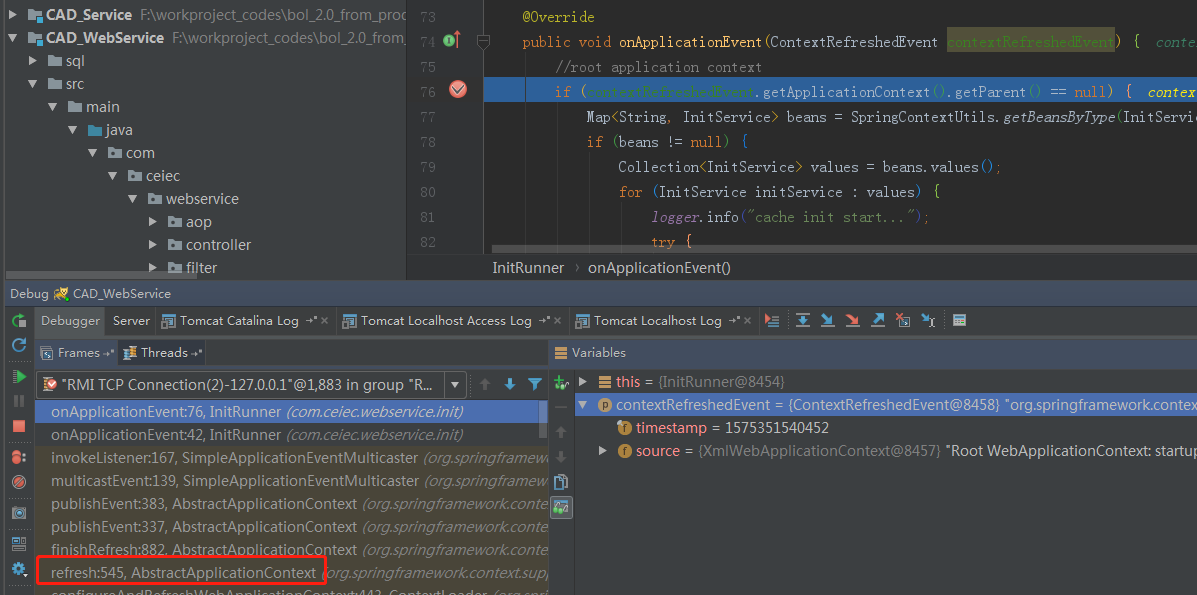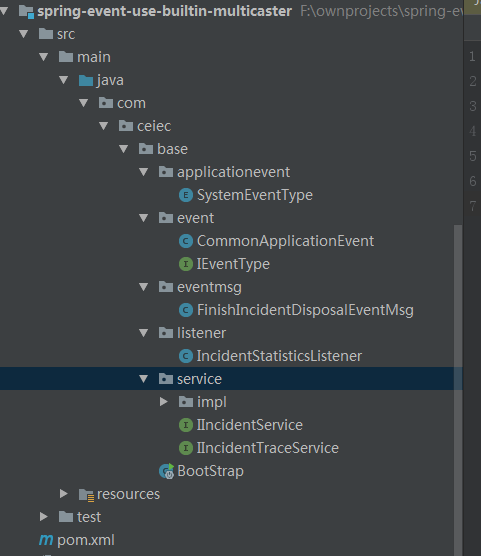从spring源码汲取营养:模仿spring事件发布机制,解耦业务代码
前言
最近在项目中做了一项优化,对业务代码进行解耦。我们部门做的是警用系统,通俗的说,可理解为110报警。一条警情,会先后经过接警员、处警调度员、一线警员,警情是需要记录每一步的日志,是要可追溯的,比如报警人张小三在2019-12-02 00:02:01时间报警,接警员A在1分钟后,将该警情记录完成,并分派给处警调度员B,调度员B在5分钟后,分派给一线警员C,C赶到现场后,花了1个小时处理完成。
这中间,每一个接口,需要做的事情,可能就包括了:警情日志记录;警员当前任务数统计,包括待处置的任务和已经处置完成的任务;我们其实还有一个操作,就是发mq,去通知其他相关人,比如接警员A接警完成后,要发mq通知其主管。
以前的代码可能是这样的:
## 接口1里, 接收警情service里完成以下操作void 接收警情(xxxReqVo reqVo){1:写库2:记录警情跟踪日志3:增加当前接警员的接警数4:发mq通知其他相关人}##接口2里,分派警情的service里完成以下操作void 分派警情(xxxReqVo reqVo){1:写库2:记录警情跟踪日志3:增加当前处警调度警员的处警数4:发mq通知其他相关人}
这样的问题是什么呢?
- 在每一个相关接口里,都要“显式”调用:记录跟踪日志的相关方法、统计相关的方法、发mq相关的方法;但凡有一个地方忘记了,都会导致问题,比如统计数量不准,mq忘发,跟踪日志遗漏等。
- 业务逻辑和这类通用业务揉在一起,假设下次又需要给报警人发个短信,岂不是又得去改核心代码?这不符合我们“对修改关闭,对扩展开放”的开闭原则啊;假设脑残的产品经理,这次说要给报警人发短信,过两天又不要了,难道每个接口,挨个挨个改吗,想想都想打死产品经理,但是这个又犯法,还是想想其他办法?
这个问题,我们可以用类似mq的方法来解决,即,发送消息,各个消费者去消费。一般,mq的方式适用于微服务之间,而我们这里,将使用事件-发布机制来解决这个问题。
源码地址(直接dubug跟一下,很简单,比看文章来得快):
https://gitee.com/ckl111/spring-event-publish-demo
先说说ApplicationListener
在spring boot之前的spring 时代,想必一些同学用过org.springframework.context.ApplicationListener,正好我手里有一个老项目,也用到了这个东西,我就拿这个举个例子:
在我们的项目中,需要在启动后,初始化一些东西,比如预热缓存,最早的代码呢,可能是大家各自实现org.springframework.beans.factory.InitializingBean,但是这样呢,初始化代码散落在各个service中;还有一些直接使用@PostContruct注解,然后在对应方法里去完成一些初始化操作。但是总体来说,这些方式,在spring的启动过程中,被调用的时机比较靠前,有些候某些bean可能还没初始化完成,而导致一些奇怪的问题。
所以,我们后来统一去掉了这些初始化代码,全部采用以下机制来实现:
import org.springframework.context.ApplicationListener;import org.springframework.context.event.ContextRefreshedEvent;@Servicepublic class InitRunner implements ApplicationListener<ContextRefreshedEvent> {@Autowiredprivate InitService initService;@Overridepublic void onApplicationEvent(ContextRefreshedEvent contextRefreshedEvent) {//root application context,因为是web项目,if (contextRefreshedEvent.getApplicationContext().getParent() == null) {initService.init();}}
在这个类中,我们实现了org.springframework.context.ApplicationListener<ContextRefreshedEvent> ,这个 listener的定义如下:
public interface ApplicationListener<E extends ApplicationEvent> extends EventListener {/*** Handle an application event.* @param event the event to respond to*/void onApplicationEvent(E event);}
接口 EventListener 是 jdk 的一个 marker interface:
package java.util;/**- A tagging interface that all event listener interfaces must extend.- @since JDK1.1*/public interface EventListener {}
我们在实现listener时,指定了本listener感兴趣的事件:ContextRefreshedEvent,这个事件的类继承关系如下:

那么,这个事件是什么意思呢?
/*** Event raised when an {@code ApplicationContext} gets initialized or refreshed.** @author Juergen Hoeller* @since 04.03.2003* @see ContextClosedEvent*/@SuppressWarnings("serial")public class ContextRefreshedEvent extends ApplicationContextEvent {/*** Create a new ContextRefreshedEvent.* @param source the {@code ApplicationContext} that has been initialized* or refreshed (must not be {@code null})*/public ContextRefreshedEvent(ApplicationContext source) {super(source);}}
注释说:Event raised when an {@code ApplicationContext} gets initialized or refreshed.,那么意思就是,该事件,是在上下文初始化完成后被发布。
这样的话,就能保证,在我们listener监听到这个事件的时候,整个应用上下文已经可以使用了。
一览Spring事件监听机制
我们再通过debug,来看看其真实的调用时机:

上图红框处,对spring上下文进行refresh,refresh就是spring 最核心的部分了,基本上,看懂了这个函数,就懂了一半:
// Prepare this context for refreshing.prepareRefresh();// Tell the subclass to refresh the internal bean factory.ConfigurableListableBeanFactory beanFactory = obtainFreshBeanFactory();// Prepare the bean factory for use in this context.// 实例化beanFactoryprepareBeanFactory(beanFactory);try {// Allows post-processing of the bean factory in context subclasses.// 对beanFactory进行处理postProcessBeanFactory(beanFactory);// Invoke factory processors registered as beans in the context.// BeanFactoryPostProcessor开始作用的地方,这里会调用所有的beanFactory后置处理器invokeBeanFactoryPostProcessors(beanFactory);// Register bean processors that intercept bean creation.// 注册 bean的后置处理器到beanFactory,注意,截止目前,还没开始实例化bean(除了少数几个内部bean)registerBeanPostProcessors(beanFactory);// Initialize message source for this context.// 注册国际化相关beaninitMessageSource();// Initialize event multicaster for this context.// 注册事件发布器,这个和本文主题大有关系initApplicationEventMulticaster();// Initialize other special beans in specific context subclasses.//注意上面这行注释,这个类是交给子类覆盖的,比如,在 org.springframework.web.context.support.AbstractRefreshableWebApplicationContext中,实例化了 org.springframework.ui.context.ThemeSourceonRefresh();// Check for listener beans and register them.// 从spring容器上下文中,查找ApplicationListener类型的监听器,添加到前两步,初始化的事件发布器中registerListeners();// Instantiate all remaining (non-lazy-init) singletons.//注意:截止到目前为止,beanFactory里面基本还是空空如也,没有bean,只有BeanDefinition,在这一步才会 //根据那些BeanDefinition来实例化那些:非lazy-init的beanfinishBeanFactoryInitialization(beanFactory);// Last step: publish corresponding event.// 发布:容器完成初始化的事件finishRefresh();}
上面基本都加了注释,比较容易懂,需要重点关注的是:
- 事件发布器初始化
initApplicationEventMulticaster();
这一步会生成一个org.springframework.context.event.ApplicationEventMulticaster,存储在org.springframework.context.support.AbstractApplicationContext#applicationEventMulticaster
该事件发布器的接口主要有(去除了无关方法):
/*** Add a listener to be notified of all events.* @param listener the listener to add*/void addApplicationListener(ApplicationListener<?> listener);/*** Multicast the given application event to appropriate listeners.* <p>Consider using {@link #multicastEvent(ApplicationEvent, ResolvableType)}* if possible as it provides a better support for generics-based events.* @param event the event to multicast*/void multicastEvent(ApplicationEvent event);
从上面可以看出,该接口主要是维护监听器ApplicationListener,以及进行事件发布。
注册监听器
// 注册listenersprotected void registerListeners() {// Register statically specified listeners first.for (ApplicationListener<?> listener : getApplicationListeners()) {getApplicationEventMulticaster().addApplicationListener(listener);}// Do not initialize FactoryBeans here: We need to leave all regular beans// uninitialized to let post-processors apply to them!//这里的这句注释也很魔性,哈哈,侧面说明了,截至目前,beanFactory都是没有bean实例存在的,bean还没 //有实例化String[] listenerBeanNames = getBeanNamesForType(ApplicationListener.class, true, false);for (String listenerBeanName : listenerBeanNames) {getApplicationEventMulticaster().addApplicationListenerBean(listenerBeanName);}
beanFactory初始化完成后,发布事件
protected void finishRefresh() {// Publish the final event.// 发布上下文refresh完毕的事件,通知listenerpublishEvent(new ContextRefreshedEvent(this));}
这里,publishEvent实现如下:
protected void publishEvent(Object event, ResolvableType eventType) {// Decorate event as an ApplicationEvent if necessaryApplicationEvent applicationEvent;if (event instanceof ApplicationEvent) {applicationEvent = (ApplicationEvent) event;}getApplicationEventMulticaster().multicastEvent(applicationEvent, eventType);}
方案1:参考spring,实现自己的事件监听机制,解耦业务代码
项目源码地址:https://gitee.com/ckl111/spring-event-publish-demo.git
项目结构如下:

定义与实现事件发布器
package com.ceiec.base.event;import org.springframework.context.event.ApplicationEventMulticaster;/*** desc:* 参考spring的设计* {@link ApplicationEventMulticaster}* @author : ckl* creat_date: 2019/11/16 0016* creat_time: 10:40**/public interface ICommonApplicationEventMulticaster {/*** Add a listener to be notified of all events.* @param listener the listener to add*/void addApplicationListener(ICommonApplicationEventListener<?> listener);/*** Multicast the given application event to appropriate listeners.* @param event the event to multicast*/void multicastEvent(CommonApplicationEvent event);}
package com.ceiec.base.event;import lombok.extern.slf4j.Slf4j;import org.springframework.context.event.SimpleApplicationEventMulticaster;import org.springframework.stereotype.Component;import java.util.LinkedHashSet;import java.util.Set;/*** desc:* 参考spring* {@link SimpleApplicationEventMulticaster}** @author : ckl* creat_date: 2019/11/16 0016* creat_time: 10:40**/@Slf4j@Componentpublic class CommonApplicationEventMulticaster implements ICommonApplicationEventMulticaster {public final Set<ICommonApplicationEventListener<?>> applicationListeners = new LinkedHashSet<>();@Overridepublic void addApplicationListener(ICommonApplicationEventListener<?> listener) {applicationListeners.add(listener);}@Overridepublic void removeApplicationListener(ICommonApplicationEventListener<?> listener) {applicationListeners.remove(listener);}@Overridepublic void removeAllListeners() {applicationListeners.clear();}@Override@SuppressWarnings({"rawtypes", "unchecked"})public void multicastEvent(CommonApplicationEvent event) {try {for (ICommonApplicationEventListener applicationListener : applicationListeners) {//判断listener是否支持处理该事件,如果支持,则丢给listener处理if (applicationListener.supportsEventType(event)) {applicationListener.onApplicationEvent(event);}}} catch (Exception e) {log.error("{}",e);}}}
定义listener
package com.ceiec.base.event;import org.springframework.context.ApplicationListener;import java.util.EventListener;/*** desc:* 参考spring* {@link ApplicationListener}* @author : ckl* creat_date: 2019/11/16 0016* creat_time: 10:45**/public interface ICommonApplicationEventListener<E extends CommonApplicationEvent> extends EventListener {boolean supportsEventType(E event );/*** Handle an application event.* @param event the event to respond to*/void onApplicationEvent(E event);}
定义事件类
package com.ceiec.base.event;import lombok.AllArgsConstructor;import lombok.Data;import lombok.experimental.Accessors;import java.util.EventObject;/*** desc:* 参考spring的设计* {@link org.springframework.context.ApplicationEvent}**/@Data@AllArgsConstructor@Accessors(chain = true)public class CommonApplicationEvent<T>{/*** 事件类型*/private IEventType iEventType;/*** 事件携带的数据*/private T data;}
listener的样例实现,下面的实现,用于警情的跟踪日志记录
package com.ceiec.base.listener;import com.ceiec.base.applicationevent.SystemEventType;import com.ceiec.base.event.CommonApplicationEvent;import com.ceiec.base.event.ICommonApplicationEventListener;import com.ceiec.base.eventmsg.*;import com.ceiec.base.service.IIncidentTraceService;import lombok.extern.slf4j.Slf4j;import org.springframework.beans.factory.annotation.Autowired;import org.springframework.stereotype.Component;/*** desc:* 接警统计listener* @author : ckl* creat_date: 2019/11/16 0016* creat_time: 9:56**/@Component@Slf4jpublic class IncidentTraceListener implements ICommonApplicationEventListener{@Autowiredprivate IIncidentTraceService iIncidentTraceService;@Overridepublic boolean supportsEventType(CommonApplicationEvent event) {return true;}@Overridepublic void onApplicationEvent(CommonApplicationEvent event) {log.info("{}",event);Object data = event.getData();if (event.getIEventType() == SystemEventType.FINISH_INCIDENT_APPEAL) {FinishIncidentDisposalEventMsg msg = (FinishIncidentDisposalEventMsg) data;iIncidentTraceService.finishIncidentDisposal(msg);}}}
启动程序时,注册listener到事件发布器
package com.ceiec.base.init;import com.ceiec.base.event.CommonApplicationEventMulticaster;import com.ceiec.base.event.ICommonApplicationEventListener;import lombok.extern.slf4j.Slf4j;import org.springframework.beans.BeansException;import org.springframework.beans.factory.annotation.Autowired;import org.springframework.boot.CommandLineRunner;import org.springframework.context.ApplicationContext;import org.springframework.context.ApplicationContextAware;import org.springframework.stereotype.Component;import java.util.Collection;import java.util.Map;/*** desc:** @author : ckl* creat_date: 2019/11/11 0011* creat_time: 15:46**/@Component@Slf4jpublic class InitRunner implements CommandLineRunner,ApplicationContextAware {private ApplicationContext applicationContext;@Autowiredprivate CommonApplicationEventMulticaster commonApplicationEventMulticaster;@Overridepublic void run(String... args) throws Exception {Map<String, ICommonApplicationEventListener> map = applicationContext.getBeansOfType(ICommonApplicationEventListener.class);Collection<ICommonApplicationEventListener> listeners = map.values();for (ICommonApplicationEventListener listener : listeners) {/*** 注册事件listener到事件发布器*/log.info("register listener:{}",listener);commonApplicationEventMulticaster.addApplicationListener(listener);}}@Overridepublic void setApplicationContext(ApplicationContext applicationContext) throws BeansException {this.applicationContext = applicationContext;}}
定义endpoint,在service中进行事件发布
controller:
@Autowiredprivate IIncidentService iIncidentService;@RequestMapping("/test.do")public String finishIncident() {iIncidentService.finishIncident();return "success";}
service:
@Slf4j@Servicepublic class IIncidentServiceImpl implements IIncidentService {@Autowiredprivate CommonApplicationEventMulticaster commonApplicationEventMulticaster;@Overridepublic void finishIncident() {FinishIncidentDisposalEventMsg msg = new FinishIncidentDisposalEventMsg();msg.setIncidentInformationId(1111L);msg.setDesc("处置完成");CommonApplicationEvent event = new CommonApplicationEvent(SystemEventType.FINISH_INCIDENT_APPEAL,msg);commonApplicationEventMulticaster.multicastEvent(event);}}
效果展示
启动时,注册listener:
2019-12-03 16:49:47.477 INFO 493432 --- [ main] com.ceiec.base.BootStrap : Started BootStrap in 1.436 seconds (JVM running for 2.22)2019-12-03 16:49:47.478 INFO 493432 --- [ main] com.ceiec.base.init.InitRunner : register listener:com.ceiec.base.listener.IncidentStatisticsListener@c6b2dd92019-12-03 16:49:47.479 INFO 493432 --- [ main] com.ceiec.base.init.InitRunner : register listener:com.ceiec.base.listener.IncidentTraceListener@3f985a862019-12-03 16:49:47.479 INFO 493432 --- [ main] com.ceiec.base.init.InitRunner : register listener:com.ceiec.base.listener.MqListener@57a2ed35
浏览器中,请求http://localhost:8081/test.do,日志如下:

方案2:直接使用spring内置的事件发布器,解耦业务代码
源码:https://gitee.com/ckl111/spring-event-publish-demo/tree/master/spring-event-use-builtin-multicaster
这部分,比上面的方案相比,少了很多东西,只包含如下部分:

总的来说,listener直接继承spring的ApplicationListener,事件发布器直接使用spring的org.springframework.context.ApplicationEventPublisher
核心代码:
package com.ceiec.base.service.impl;import com.ceiec.base.applicationevent.SystemEventType;import com.ceiec.base.event.CommonApplicationEvent;import com.ceiec.base.eventmsg.FinishIncidentDisposalEventMsg;import com.ceiec.base.service.IIncidentService;import lombok.extern.slf4j.Slf4j;import org.springframework.beans.factory.annotation.Autowired;import org.springframework.context.ApplicationEvent;import org.springframework.context.ApplicationEventPublisher;import org.springframework.stereotype.Service;/*** desc:* 发布事件的业务代码示例* @author : ckl* creat_date: 2019/12/2 0002* creat_time: 14:27**/@Slf4j@Servicepublic class IIncidentServiceImpl implements IIncidentService {@Autowiredprivate ApplicationEventPublisher applicationEventPublisher;@Overridepublic void finishIncident() {FinishIncidentDisposalEventMsg msg = new FinishIncidentDisposalEventMsg();msg.setIncidentInformationId(1111L);msg.setDesc("处置完成");CommonApplicationEvent event = new CommonApplicationEvent(SystemEventType.FINISH_INCIDENT_APPEAL,msg);applicationEventPublisher.publishEvent(event);}}
package com.ceiec.base.listener;import com.ceiec.base.applicationevent.SystemEventType;import com.ceiec.base.event.CommonApplicationEvent;import lombok.extern.slf4j.Slf4j;import org.springframework.context.ApplicationListener;import org.springframework.stereotype.Component;/*** desc:* 这里,直接继承 spring 的listener* @author : ckl* creat_date: 2019/11/16 0016* creat_time: 9:56**/@Component@Slf4jpublic class IncidentStatisticsListener implements ApplicationListener<CommonApplicationEvent> {@Overridepublic void onApplicationEvent(CommonApplicationEvent event) {log.info("receive event:{}",event);}}
总结
以上两种都可以用,一个是自己仿的,定制性强一点;一个直接用spring的。大家自由选择即可。
通过这样的方式,我们的业务代码,可以做到解耦,大体和mq其实是类似的。
从spring源码汲取营养:模仿spring事件发布机制,解耦业务代码的更多相关文章
- spring源码分析系列 (3) spring拓展接口InstantiationAwareBeanPostProcessor
更多文章点击--spring源码分析系列 主要分析内容: 一.InstantiationAwareBeanPostProcessor简述与demo示例 二.InstantiationAwareBean ...
- Spring源码深度解析之Spring MVC
Spring源码深度解析之Spring MVC Spring框架提供了构建Web应用程序的全功能MVC模块.通过策略接口,Spring框架是高度可配置的,而且支持多种视图技术,例如JavaServer ...
- Spring 源码学习笔记10——Spring AOP
Spring 源码学习笔记10--Spring AOP 参考书籍<Spring技术内幕>Spring AOP的实现章节 书有点老,但是里面一些概念还是总结比较到位 源码基于Spring-a ...
- Spring 源码学习笔记11——Spring事务
Spring 源码学习笔记11--Spring事务 Spring事务是基于Spring Aop的扩展 AOP的知识参见<Spring 源码学习笔记10--Spring AOP> 图片参考了 ...
- spring源码分析系列 (8) FactoryBean工厂类机制
更多文章点击--spring源码分析系列 1.FactoryBean设计目的以及使用 2.FactoryBean工厂类机制运行机制分析 1.FactoryBean设计目的以及使用 FactoryBea ...
- spring源码分析系列 (5) spring BeanFactoryPostProcessor拓展类PropertyPlaceholderConfigurer、PropertySourcesPlaceholderConfigurer解析
更多文章点击--spring源码分析系列 主要分析内容: 1.拓展类简述: 拓展类使用demo和自定义替换符号 2.继承图UML解析和源码分析 (源码基于spring 5.1.3.RELEASE分析) ...
- spring源码分析系列 (1) spring拓展接口BeanFactoryPostProcessor、BeanDefinitionRegistryPostProcessor
更多文章点击--spring源码分析系列 主要分析内容: 一.BeanFactoryPostProcessor.BeanDefinitionRegistryPostProcessor简述与demo示例 ...
- spring源码分析系列 (2) spring拓展接口BeanPostProcessor
Spring更多分析--spring源码分析系列 主要分析内容: 一.BeanPostProcessor简述与demo示例 二.BeanPostProcessor源码分析:注册时机和触发点 (源码基于 ...
- Spring源码剖析2:Spring IOC容器的加载过程
spring ioc 容器的加载流程 1.目标:熟练使用spring,并分析其源码,了解其中的思想.这篇主要介绍spring ioc 容器的加载 2.前提条件:会使用debug 3.源码分析方法:In ...
随机推荐
- 使用grep过滤make的输出内容
make的输出内容其实分为两种,有些是到标准输出,有些是到标准错误,由于标准输出和标准错误默认都是屏幕,所以平时区分不出来, 实际上一般是error和warning信息到标准错误,其余的到标准输出. ...
- Docker安装方法整理
目录 安装准备 在线安装 离线安装 Raspbian便捷脚本安装 卸载 安装准备: 卸载旧版本 较旧版本的Docker被称为docker或docker-engine.如果已安装,请卸载它们: sudo ...
- ArcGIS Engine制作DIY地图工具
本节将向你介绍,利用ToolStrip制作自定义GIS工具条. 步骤如下: ①向ToolStrip中添加一个Button ②向该Button的lmg属性添加图片素材,并将Button的图片比例(Ima ...
- 盘点一下Creator星球上的开源工具包!
晓衡开始写公众号,最早是从上架 Cocos 商店的 pbkiller 插件开始的,到至今有2年2个月了.在这期间,又陆续在公众号上分享了多个实用工具包,在这里统一盘点一下,方便与大家交流学习. 一.u ...
- CTR@因子分解机(FM)
1. FM算法 FM(Factor Machine,因子分解机)算法是一种基于矩阵分解的机器学习算法,为了解决大规模稀疏数据中的特征组合问题.FM算法是推荐领域被验证效果较好的推荐算法之一,在电商.广 ...
- Mysql常用数据类型归纳总结1
一直在用Mysql数据库,Mysql的数据类型也最常打交道的.但关于Mysql的一些常用数据类型了解程度仅限于一知半解,仅仅能满足满足于平时一些最简单的操作.而Mysql常用数据类型的定义以及规范理解 ...
- 学习笔记25_MVC前台API
**当请求url的规则有所改变时,前台的所有超链接的href都得改,为了避免多处修改,可以href = "< %=url.Action("Controller",& ...
- [考试反思]0926csp-s模拟测试52:审判
也好. 该来的迟早会来. 反思再说吧. 向下跳过直到另一条分界线 %%%cbx也拿到了他的第一个AK了呢. 我的还是遥不可及. 我恨你,DeepinC. 我恨透你了.你亲手埋葬所有希望,令我无比气愤. ...
- Function题解
这个题最优策略一定是向左上走到某一列再往上一直走. n*q在线暴力可做,离线按y排序,单调栈维护凸壳. 具体来说:对于i<j若A[i]>A[j] 即j的斜率小而且纵截距小,一定比i优,并且 ...
- Redis集群--Redis集群之哨兵模式
echo编辑整理,欢迎转载,转载请声明文章来源.欢迎添加echo微信(微信号:t2421499075)交流学习. 百战不败,依不自称常胜,百败不颓,依能奋力前行.--这才是真正的堪称强大!!! 搭建R ...
